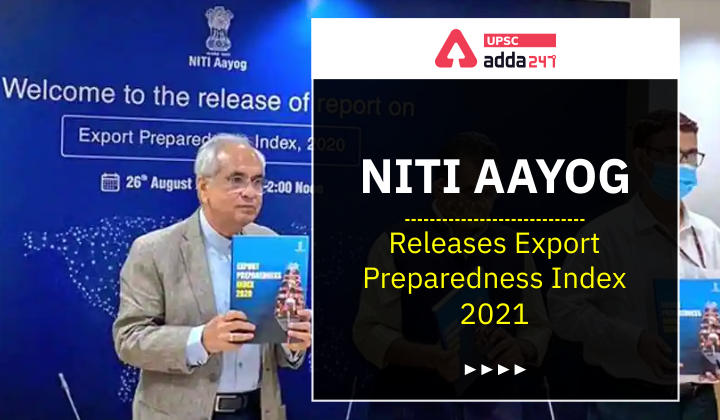Table of Contents
Export Preparedness Index UPSC: Relevance
- GS 3: Indian Economy and issues relating to planning, mobilization, of resources, growth, development and employment.
Export Preparedness Index: Context
- Recently, NITI Aayog has released the second edition of Export Preparedness Index (EPI) 2021, in partnership with the Institute of Competitiveness.
Export Preparedness Index 2021: Key points
- The Export Preparedness Index is a data-driven endeavour to identify the fundamental areas critical for subnational export promotion.
- The EPI’s primary goal is to instil competition among all Indian states (‘Coastal’, ‘Landlocked’, ‘Himalayan’, and ‘UTs/City-States’).
- The index can be a valuable tool for the government and policymakers in encouraging healthy competition among states and UTs, hence enhancing India’s standing in the global export market.
EPI objectives
- to bring about favourable export-promotion policies,
- ease the regulatory framework to prompt subnational export promotion,
- create the necessary infrastructure for exports, and
- assist in identifying strategic recommendations for improving export competitiveness.
Export Preparedness Index: Key findings
- Overall Ranking: Gujarat ranked No. 1 for the second time in a row.
- Most of the Coastal States are the best performers.
- Coastal state: Gujarat topped the list of coastal states.
- From landlocked states, Haryana emerges as a top performer.
- Except for trade support and export growth and orientation, the state has performed tremendously well across all pillars and sub-pillars.
- Himalayan states: Uttarakhand has topped the list of Himalayan states.
- Uttarakhand has attracted significant investments over the last three years.
- It has brought initiatives such as single-window clearances, a loan scheme for exporters, a trade guide and further improved export market penetration
- Among UTs: Delhi has topped the list of UTs.
- Delhi performs well on EPI due to higher FDI inflows, better transport connectivity, logistics and investment attracted.
Challenges to India’s export promotion
EPI 2021 brings out three major challenges to India’s export promotion.
- Intra- and inter-regional differences in export infrastructure;
- weak trade support and growth orientation across states; and
- lack of R&D infrastructure to promote complex and unique exports.
EPI pillars and sub-pillars
The EPI ranks states and UTs on 4 main pillars
- Policy: A comprehensive trade policy provides a strategic direction for exports and imports.
- Business Ecosystem: An efficient business ecosystem can help attract investments and create an enabling infrastructure for businesses to grow.
- Export Ecosystem: This pillar aims to assess the business environment, which is specific to exports.
- Export Performance: This is the only output-based pillar and examines the reach of export footprints of states and union territories.
EPI 11 sub-pillars
- Export Promotion Policy; Institutional Framework; Business Environment; Infrastructure; Transport Connectivity; Access to Finance; Export Infrastructure; Trade Support; R&D Infrastructure; Export Diversification; and Growth Orientation.





 TSPSC Group 1 Question Paper 2024, Downl...
TSPSC Group 1 Question Paper 2024, Downl...
 TSPSC Group 1 Answer key 2024 Out, Downl...
TSPSC Group 1 Answer key 2024 Out, Downl...
 Cabinet Ministers of India 2024, New Cab...
Cabinet Ministers of India 2024, New Cab...







